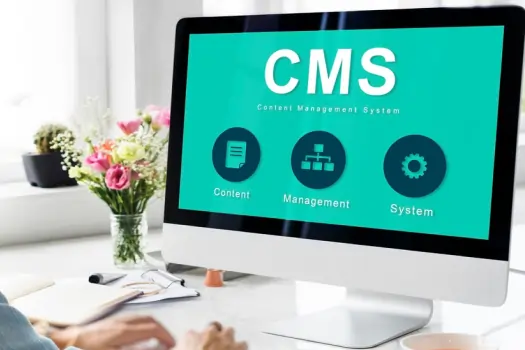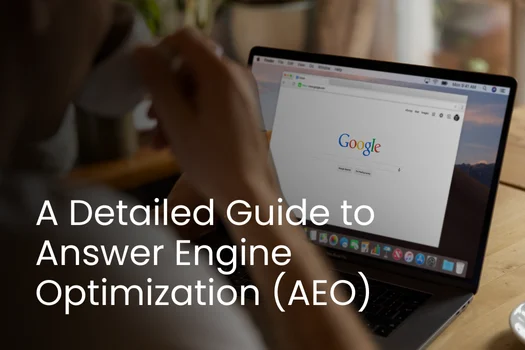Contents
- What is a headless CMS?
- The origin of headless CMS
- Benefits of using a headless CMS
- Why Contentful is a leading headless CMS?
- The difference between headless CMS and traditional CMS
- How to get started with Contentful?
- Use cases for Contentful headless CMS
- Challenges of using a headless CMS
- Conclusion
The previous standard for web development was the traditional content management system architecture.
However, as business needs and customer expectations have become more complex, the common technology used these days is known as headless CMS or headless content management system.
In this guide, we will explore what is headless cms, its benefits, how it differs from traditional CMS, and why Contentful is a leading choice in this arena.
What is a headless CMS?
A headless CMS separates the content management system (CMS) from the content delivery layer (CDN).
Unlike traditional CMS platforms, which are monolithic and tightly integrated with the front end, a headless CMS focuses solely on the back-end content management capabilities.
This means that content can be delivered to any front end through APIs, allowing for greater flexibility in how and where content is presented.
The origin of headless CMS
To appreciate the headless CMS, we must first understand the limitations of traditional CMSs. Platforms like WordPress, Drupal, and Sitecore were initially developed to store and present content—text, images, videos—specifically for websites.
These systems combined content with HTML, CSS, and other code, challenging the reuse of content across different platforms. As digital channels and devices increased, the need for more adaptable solutions became apparent.
Traditional CMSs, designed for single-channel content delivery, could not keep pace. This gap led to the development of headless CMSs, which separate content management from presentation, allowing content to be used flexibly across websites, mobile apps, digital displays, and more.
Our Contentful services offer a robust headless CMS solution for managing and delivering content seamlessly.
Benefits of using a headless CMS
- Flexibility: Headless CMS allows developers to create content once and deliver it anywhere across multiple channels and devices, making it ideal for omnichannel strategies.
- Scalability: As businesses grow, the demand for more content and the need to deliver it across various platforms increases. Headless CMS scales effortlessly to meet these demands.
- Faster Development: Decoupling the front-end and back-end enables parallel development, speeding up the overall development process.
- Improved Performance: Since headless CMS is not tied to a specific front-end, it can be optimized independently, leading to better performance and faster load times for end users.
- Security: Separating the content management from the presentation layer can reduce the risk of security vulnerabilities, as the content is served through APIs with controlled access.
Why Contentful is a leading headless CMS?
Contentful has established itself as a frontrunner in the headless CMS space. Here's why:
- Robust API: Contentful's API-first approach ensures seamless integration with various front-end frameworks and third-party services.
- Rich Content Modeling: Contentful offers flexible content modeling capabilities, allowing businesses to create custom content structures tailored to their needs..
- Scalability and Performance: Contentful's cloud-native architecture ensures high performance and scalability, making it suitable for businesses of all sizes.
- Extensive Integrations: With a vast ecosystem of integrations, Contentful can connect with numerous tools and services, enhancing its functionality.
- User-Friendly Interface: Contentful’s design is simple, allowing content creators to work with and edit content without coding knowledge.
- Content Preview: Contentful offers a preview feature that allows content creators to see how their content will look on different devices and platforms before publishing.
- Localization Support: Contentful supports multiple languages and locales, making it easier for global businesses to manage and deliver localized content.
The difference between headless CMS and traditional CMS
Hosting and Delivery
- Traditional CMS: Typically hosted in-house with content tightly coupled to specific delivery methods.
- Headless CMS: Cloud-based, delivering content via APIs to any platform or device.
Development Mindset
- Traditional CMS: Project-focused, with content and code interwoven.
- Headless CMS: Product-focused, enabling content to be a building block for various products and experiences.
Content Model
- Traditional CMS: Built for single-page delivery, making content reuse difficult.
- Headless CMS: Designed for reuse, supporting multiple products and channels.
Supported Devices
- Traditional CMS: Limited to web content.
- Headless CMS: Limitless, supporting websites, mobile apps, IoT devices, and more.
Workflow
- Traditional CMS: Often follows a waterfall model.
- Headless CMS: Agile, enabling faster updates and continuous improvement.
Updates
- Traditional CMS: Scheduled, often requiring downtime.
- Headless CMS: Continuous, with minimal disruption.
Backend System
- Traditional CMS: Monolithic and all-in-one.
- Headless CMS: Microservice-based, integrating best-in-class solutions.
Investment
- Traditional CMS: High upfront costs and inherent technical debt.
- Headless CMS: Quick proof of concept with managed technical debt.
How to get started with Contentful?
- Sign Up: Go to Contentful’s website, sign up for an account, and select the right plan for your business.
- Set Up Your Space: A space in Contentful is a container for all your content. Create a space and define the content models you'll need.
- Create Content: Start adding content to your space. Contentful's rich text editor and media library make creating and managing content easy.
- Integrate with Your Front-End: Use Contentful's APIs to fetch and display content on your front-end application. Whether using React, Vue.js, Angular, or any other framework, Contentful's API can seamlessly deliver content to your application.
- Publish and Iterate: Once your content is integrated and displayed on your front end, you can publish it. Contentful makes it easy to iterate and update content as needed, ensuring your digital presence remains dynamic and up-to-date.
- Leverage Webhooks: Contentful supports webhooks, which can automate workflows and trigger actions in response to content changes.
- Optimize for SEO: Ensure your content is optimized for search engines by using Contentful's metadata fields and integrating them with SEO tools.
Use cases for Contentful headless CMS
- E-commerce: Deliver personalized shopping experiences across web, mobile, and IoT devices. A contentful headless CMS can power dynamic product catalogues, personalized recommendations, and seamless checkout processes.
- Mobile Apps: Manage content for mobile applications without the need to release new app versions. Contentful allows for real-time updates and ensures a consistent user experience across different devices.
- Digital Signage: Power digital displays and signage with dynamic content updates. This is especially helpful for retail, hospitality, and corporate spaces where the content changes often.
- IoT Devices: Serve content to IoT devices, such as smart speakers and wearables, providing a consistent user experience. A contentful headless CMS can manage voice content, notifications, and other interactive features.
- Websites and Portals: Create and manage content for websites and portals with complex content structures and high traffic demands. Contentful's scalability and performance make it ideal for enterprise-level websites.
- Gaming: Manage and deliver in-game content updates, such as new levels, characters, and events, without requiring players to download new game versions.
- Media and Publishing: Streamline media and publishing companies' content creation and distribution process. Contentful's flexible content modeling and localization support make managing large volumes of content easy.
Challenges of using a headless CMS
- Complexity: Setting up a headless CMS Contentful requires a solid understanding of front-end and back-end technologies. This may necessitate additional training for your development team.
- Learning Curve: Transitioning to a headless CMS can involve a steep learning curve for teams accustomed to traditional CMS platforms. Adapting to new workflows and tools may take time.
- Initial Costs: Although the long-term advantages are impressive, the initial configuration and implementation costs are higher than in the case of traditional CMS platforms. Investing in the right resources and expertise is crucial.
- Maintenance: The headless CMS and front-end applications require constant maintenance and updates, which require constant attention. Maintenance and fine-tuning are necessary to achieve the best long-term results.
- Content Fragmentation: Content can fragment across channels and platforms without proper planning. Implementing a robust content strategy and governance framework is essential to maintaining consistency.
- Dependency on APIs: Relying heavily on APIs means that any changes or downtimes in the API services can impact your content delivery. It's essential to have contingency plans in place to handle such scenarios.
Conclusion
Transitioning to a headless CMS can revolutionize how your organization manages and delivers content.
A headless CMS provides unmatched flexibility, scalability, and performance by decoupling the back and front end.
A headless CMS is a powerful solution for improving load times, supporting multiple digital channels, or future-proofing your content management strategy.
At Saffron Edge , we specialize in helping businesses implement and optimize headless CMS solutions. Contact us today to discover how we can transform your digital content strategy and drive your business forward.
The ultimate marketing toolkit
Frequently Asked Questions
1. What are the main differences between a headless CMS and a traditional CMS?
A headless CMS decouples the content management back-end from the content display front-end so that the front end can access content through APIs. On the other hand, conventional CMS platforms, such as WordPress or Drupal, deal with content management and front-end rendering.
2. Will adopting a headless CMS require rewriting my entire website?
No, a headless CMS does not necessarily mean you need to redesign your website from scratch. You can start adopting the headless architecture by implementing the new CMS in some sections or pages and leaving the rest unchanged.
3. How does a headless CMS improve website performance?
A headless CMS gives you complete control over how your website is rendered, allowing you to choose static site generation or other methods to ensure speed.
4. What is Contentful CMS?
Contentful CMS is a modern content management system designed for creating and managing dynamic websites and content platforms. It offers flexibility and scalability through an API-first approach, enabling seamless integration across various digital channels.
5. What support do you offer after implementing Contentful CMS?
We provide SLA-based support services to ensure the health and performance of your Contentful CMS. This includes proactive monitoring, regular updates, troubleshooting, and comprehensive training for your team to maximize the platform's capabilities.
Related Blogs
We explore and publish the latest & most underrated content before it becomes a trend.
7 min read
What is SEO Semantic Markup and How to Make Your HTML SEO-Friendly?
By Vibhu Satpaul8 min read
Advanced Guide to AEO: Everything About Answer Engine Optimization
By Nishant Ahlawat
Subscribe to Saffron Edge Newsletter!

The ultimate marketing toolkit










